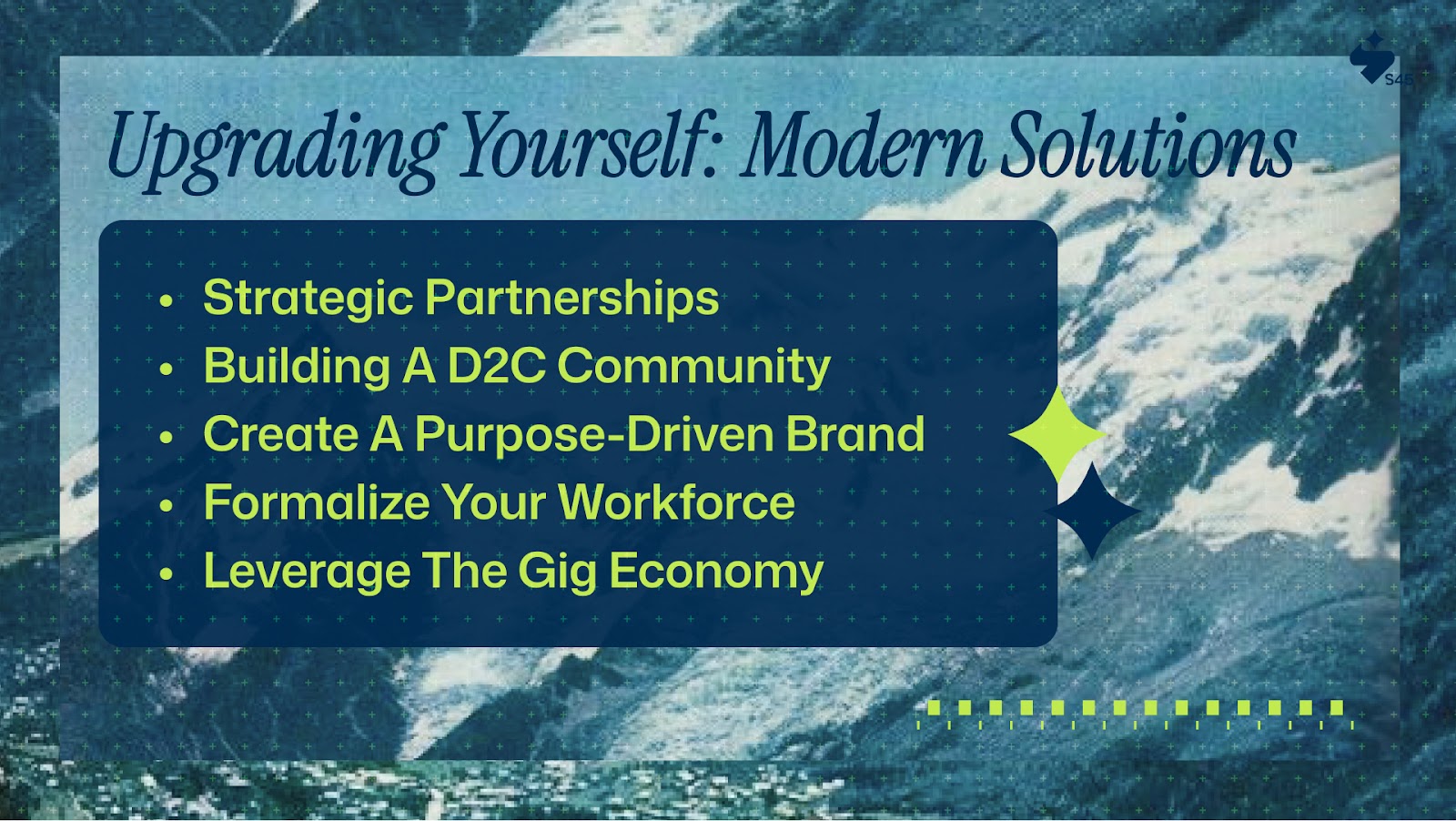
Key Takeaways
- Formalize first, scale second. Register for Udyam, maintain proper financial records, and build a digital transaction trail before seeking funding or partnerships
- Technology isn't optional anymore. Start small with cloud-based tools and government platforms like GeM and ONDC, then gradually scale your tech stack as you grow.
- Your niche is your superpower. Stop trying to compete with everyone; find an underserved market, specialize, and use your agility to outmaneuver larger competitors
- People and partnerships accelerate growth. Invest in your team's development, formalize your workforce, and collaborate strategically rather than trying to do everything alone
- Purpose drives profit. Build a brand story and "why" that customers can connect with. Today's consumers want to support businesses that stand for something meaningful.
If you’re running an MSME in India, you know the struggle of dreaming big while progress feels frustratingly slow. Despite MSMEs powering over 30% of India’s GDP, moving from micro to small, and then to medium scale, remains a tough climb for most.
Between 2020 and March 2025, only 0.4% of micro-enterprises grew into small businesses, and just 0.05% of small enterprises scaled to medium, showing exactly how steep the journey can be.
When limited access to capital, regulatory hurdles, and fast-changing markets collide with your ambition for legacy and growth, it’s easy to feel stuck. That’s why understanding the real factors affecting SME growth in India is key.
In this blog, we’ll break down the concrete challenges and share practical, actionable ways to tackle them so your business can finally scale and thrive.
Why Your Business Matters to All of Us: Importance of SME Growth in India
MSMEs are the very foundation of the Indian economy. They contribute a significant portion of the country's GDP and are the second-largest employer after agriculture, providing jobs to over 11 crore people. Their importance extends far beyond these numbers. MSMEs are crucial for:
- Employment Generation: They create a vast number of job opportunities, particularly for semi-skilled and unskilled labor in rural and semi-urban areas, fostering a more balanced and inclusive economic landscape.
- Export Promotion: MSMEs contribute a remarkable 40% to India's total exports, helping the country earn foreign exchange and strengthening its position in the global market.
- Fostering Entrepreneurship: They provide a fertile ground for new ideas and innovations, acting as incubators for the next generation of business leaders.
- Regional Development: By setting up units in remote areas, MSMEs help in the decentralization of industries, reducing the burden on major urban centers and promoting balanced growth across the country.
The health of the MSME sector is directly proportional to the health of the Indian economy. This is why your growth is not just a business goal, it's a national priority.
Understanding this context is the first step. The next step is to acknowledge the real challenges that might be holding you back.
The Roadblocks to Your Growth: Common Challenges and Smart Solutions

The path to scaling a business is rarely linear. Indian MSMEs face a unique set of challenges that can often feel like a maze. Let's break down the primary hurdles and, more importantly, discuss actionable strategies to overcome them.
1. The Capital Conundrum: From "I Need a Loan" to "How Do I Leverage Capital?"
Many small businesses run on cash transactions and basic accounting, which makes it tough for traditional banks to assess your creditworthiness. This credit gap is estimated to be over ₹16 lakh crore, and it's holding a lot of you back from getting the funding you deserve.
Actionable Tips for You:
- Get formal: Your first step is to make your business official. Register for Udyam, file your GST returns regularly, and maintain proper financial records. This gives lenders the digital footprint they need to trust you.
- Build a transaction trail: Use UPI or other digital payment systems. It might seem small, but it creates a solid financial history that can make you more attractive to fintech lenders.
- Explore alternative lending options: Don’t rely solely on traditional banks. Platforms offering invoice discounting, supply chain finance, and P2P lending can provide capital based on your receivables and purchase orders, not your assets. Additional financial support from strategic partners like S45 can offer equity and structured finance that empowers your growth at every stage.
- Improve your CIBIL score: Just like with personal loans, a strong CIBIL score helps establish your business’s financial health. Make sure to pay all loans and bills on time.
- Know your government schemes: Don't just know about MUDRA or CGTMSE, understand how they work. For example, CGTMSE offers collateral-free loans, and the Interest Subvention Scheme can reduce your interest rate by 2%. Seek these out actively!
2. The Tech Trap: From "I'm Too Small for Tech" to "I Can't Afford Not To"
You might think upgrading to the latest tech will solve your problems, but the issue isn’t just the high cost of technology; it’s the lack of a plan. A lot of MSMEs purchase tech without a clear roadmap, leading to underutilized tools and wasted money. Without proper training or integration with your existing systems, you won’t see the full benefits.
What You Can Do:
- Start small: Don’t jump into complex ERP systems right away. Begin with cloud-based tools like Zoho Books or Tally on Cloud for accounting and CRM software to keep costs low while scaling gradually.
- Leverage government-backed platforms: Use initiatives like ONDC or GeM to access more customers and government procurement opportunities without building a complex system.
- Implement Industry 4.0 in stages: No need for a fully automated factory. Start with basic IoT sensors to monitor machine health or track inventory, then expand as you grow. Partners like S45 can encourage you to think beyond "what's working now" and focus on "what will be required to build a legacy business."
- Prioritize cybersecurity: As you digitize, protect your business. Basic security tools like strong passwords and malware protection can save you from big losses.
- Encourage continuous learning: Instead of a one-off training session, make learning a habit. Use online resources like Coursera or NPTEL, and take advantage of government schemes to upskill your team.
3. The Talent Challenge: From "High Turnover" to "My People Are My Legacy"
Attracting skilled talent can be tough, especially when you can’t compete with the salaries big companies offer. But here’s the good news: you don’t have to fight for the same talent. You can build your own from within!
What You Can Do:
- Invest in your current team: Look for people who are eager to learn and grow. Offer them training opportunities to fill the skills gap, and watch how it boosts loyalty and strengthens your culture.
- Partner with local training institutes: Work with Industrial Training Institutes (ITIs) or polytechnics to bring in fresh talent. You can offer practical training on your premises, hire the top performers, and create a cost-effective talent pipeline.
- Give your employees ownership: Offer them more responsibility and involve them in decision-making. They’ll appreciate the chance to make an impact—often more than a higher salary.
- Leverage government skill development programs: Tap into government-run schemes like the Entrepreneurship and Skill Development Programme (ESDP) for specialized training at subsidized rates.
- Offer non-monetary benefits: Flexible working hours, opportunities for cross-functional learning, and a positive work culture can be just as valuable as higher pay for many employees.
4. The Regulatory Maze: From "More Paperwork" to "A Solid Foundation"
We all know how overwhelming the compliance landscape can be, with multiple regulations, different departments, and various portals to deal with. It’s a massive drain on resources that could be better spent growing your business. But instead of letting it overwhelm you, why not turn it into an advantage?
How You Can Tackle It:
- Use RegTech: Technology can simplify compliance. Use SaaS platforms that provide a central dashboard for all your regulatory obligations—from GST filings to employee benefits.
- Outsource compliance: You don’t need to handle everything in-house. Hiring a professional firm for MSME compliance can be more affordable than dealing with penalties for missed deadlines.
- Join industry bodies: Organizations like the Confederation of Indian Industry (CII) can provide resources and advocate for simpler regulations. They also offer seminars to keep you updated on regulatory changes.
- Stay proactive on Regulations: Stay ahead by regularly checking for new regulatory changes, so you’re not caught off guard. For example, understanding upcoming environmental and social governance (ESG) requirements could give you a competitive edge.
- Advocate for simplification: Take part in discussions through industry associations to help streamline the regulatory process for all MSMEs.
5. The Market Gap: From "How Do I Find Customers?" to "How Do I Build an Ecosystem?"
Yes, competition from big businesses is tough, but it’s not just the big guys you need to worry about. The bigger issue is a lack of focus. If you’re trying to compete with everyone, you’re probably not standing out. The key to success? Specialization.
What You Can Do:
- Find your niche: Don’t try to be everything to everyone. Instead, find an underserved market and become an expert in that area. Small businesses can thrive in niches that large companies often ignore.
- Use your agility: Big corporations are slow to change. You, on the other hand, can adapt quickly, launch products faster, and provide personalized service. Use this flexibility to your advantage.
- Tell your brand story: People connect with stories. Share your journey, values, and the passion behind your products. Social media platforms like Instagram and LinkedIn are great for this.
- Focus on local marketing: Optimize for Local SEO and target ads on platforms like Facebook and Instagram to reach customers nearby.
- Strategic partnerships: Team up with complementary businesses to expand your reach. For example, a bakery could partner with a local café, or a small manufacturer could collaborate with a larger company for specific parts.
These challenges can be daunting, but the growth potential is huge. When MSMEs overcome them, they don’t just grow, they transform into professional, high-growth enterprises within a sustainable, global supply chain.
But wait, there's more. Some of the most effective solutions weren't even available a few years ago.
How to Upgrade Yourself: New-Age Solutions to Old Problems

You already know the classic hurdles. But what if I told you the landscape has changed? The real opportunity today is about embracing new, creative solutions that are now available to you. Here are five tips that you can follow:
1. Collaborate to Conquer with Strategic Partnerships
Don't go it alone. Joining forces with others is a smart way to grow.
- Action: Become a vendor on government platforms or a supplier for a large company. Connect with industry clusters, B2B marketplaces, and collaborative supply chains.
- Benefit: Platforms like GeM or corporate supply chains give you steady orders and access to global quality standards, all without heavy capital investment.
2. Go Direct and Build a Community with D2C Models
While big e-commerce sites get you sales, the real power is in building a direct relationship with customers. Legacy comes from consistent innovation and staying future-ready.
- Action: Use a direct-to-consumer (D2C) model on platforms like Instagram and WhatsApp Business. Keep evolving your offerings and stay true to your values. Your purpose drives long-term success.
- Benefit: Keep more of your profits, bypass middlemen, and build a loyal community around your brand.
3. Find Your "Why" to Create a Purpose-Driven Brand
Today, people want to support businesses that stand for something more than just profit.
- Action: Embed a strong "why" into your business. For example, a food startup sourcing from local farmers isn’t just selling food; they’re creating a sustainable, ethical supply chain and leaving a social impact.
- Benefit: This purpose becomes a powerful competitive advantage and a story that customers will want to be a part of.
4. Formalize Your Workforce for Long-Term Growth
Your employees are your most valuable asset. Investing in them is a strategic move.
- Action: Formalize your team with benefits like a provident fund (PF) and health insurance.
- Benefit: Reduce employee turnover, boost morale, and attract and keep the best talent.
5. Leverage the Gig Economy for On-Demand Expertise
Can’t afford full-time experts? You don't need to hire a full-time expert for every task.
- Action: Adopt a "skill-as-a-service" model by hiring freelancers on a project basis.
- Benefit: Access top-tier expertise without the high cost of a full-time salary, allowing you to compete more effectively with larger companies.
These strategies represent a fundamental shift in how successful MSMEs operate. But implementing them requires more than just good intentions; it requires the right partner who understands your journey and shares your vision for sustainable growth.
Your Next Step: Partnering for a Purposeful Future
So where does this leave you? You now understand the challenges, you know the solutions exist, and you can see that other MSMEs are successfully implementing these strategies. The question isn't whether growth is possible; it's how you're going to make it happen.
At S45 Club, we understand that you're not just running a business; you're building a legacy. Our model is built on providing patient capital, expert guidance, and a supportive community. We focus on sustainable, capital-efficient growth, helping you maintain control and build a business that will thrive for generations.
Ready to stop dreaming about growth and start living it? Discover how S45 Club can help you scale your business sustainably. Contact us today to learn more about our founder-first approach and our hypergrowth playbook.
FAQs
Q: How long does it typically take for an MSME to see significant growth after implementing these strategies?
Most MSMEs start seeing initial improvements within 3-6 months of implementing digital systems and formalizing operations. However, substantial growth typically takes 12-18 months as market positioning strengthens and operational efficiency improves. The key is consistency and gradual implementation rather than expecting overnight results.
Q: What's the minimum investment needed to digitize my MSME operations?
You can start digitizing with as little as ₹10,000-15,000 per month. This covers basic cloud accounting software (₹2,000-3,000), digital payment systems (minimal setup cost), and basic marketing tools. The investment scales with your business size, but the ROI often justifies the cost within the first year.
Q: How do I know if my MSME is ready to scale from micro to small, or small to medium?
Key indicators include: consistent monthly revenue for 6+ months, formal financial records, at least 2-3 reliable customers, a small but stable team, and cash flow that covers expenses plus 20% buffer. If you're meeting these benchmarks and have identified a clear growth opportunity, you're likely ready for the next level.
Q: What are the biggest mistakes MSMEs make when trying to grow too fast?
The top mistakes are: hiring too quickly without proper systems, taking on debt without clear repayment plans, expanding to new markets before mastering the current one, and neglecting existing customers while chasing new ones. Growth should be sustainable, and focus on strengthening your foundation before adding new layers.


